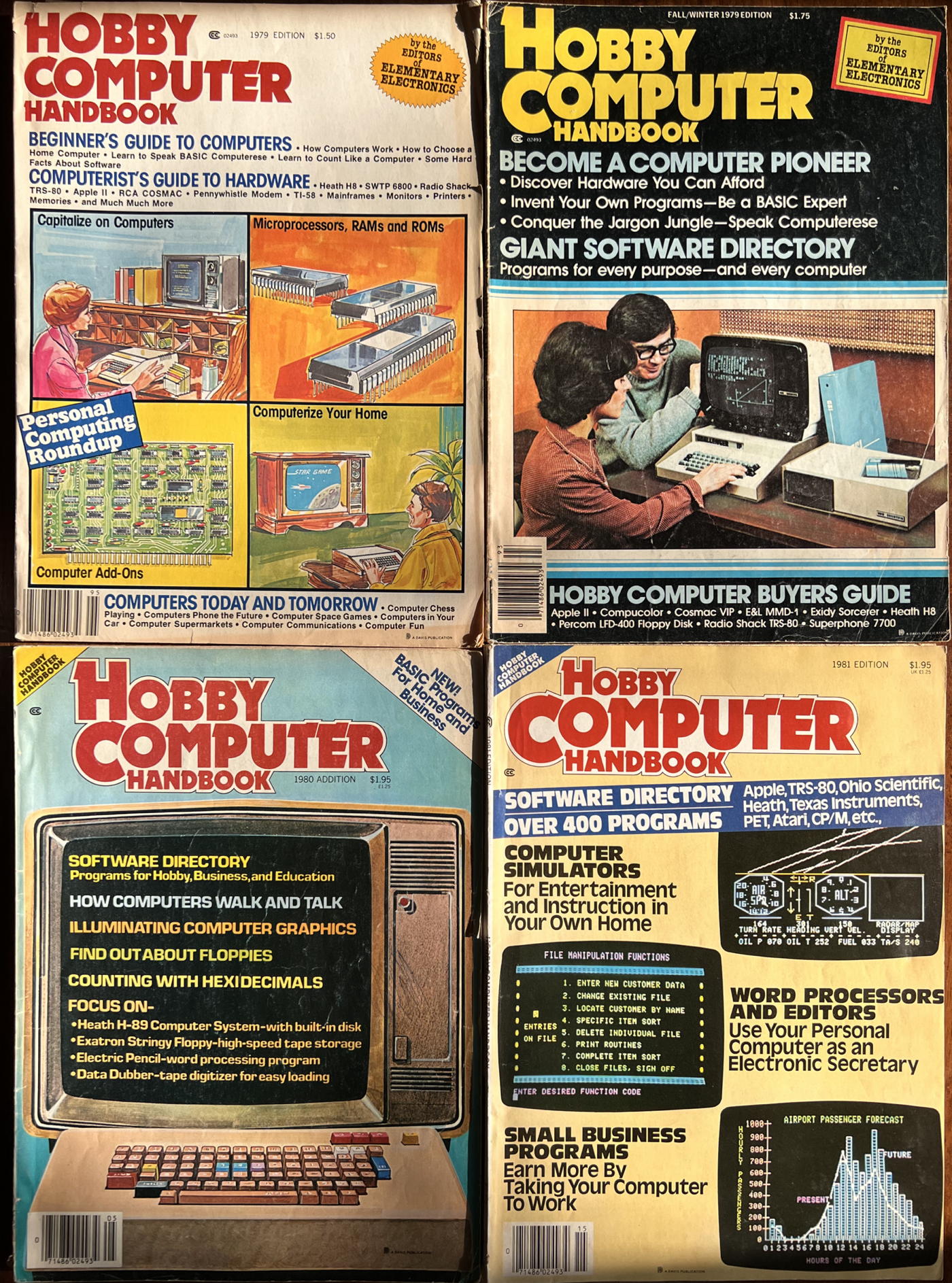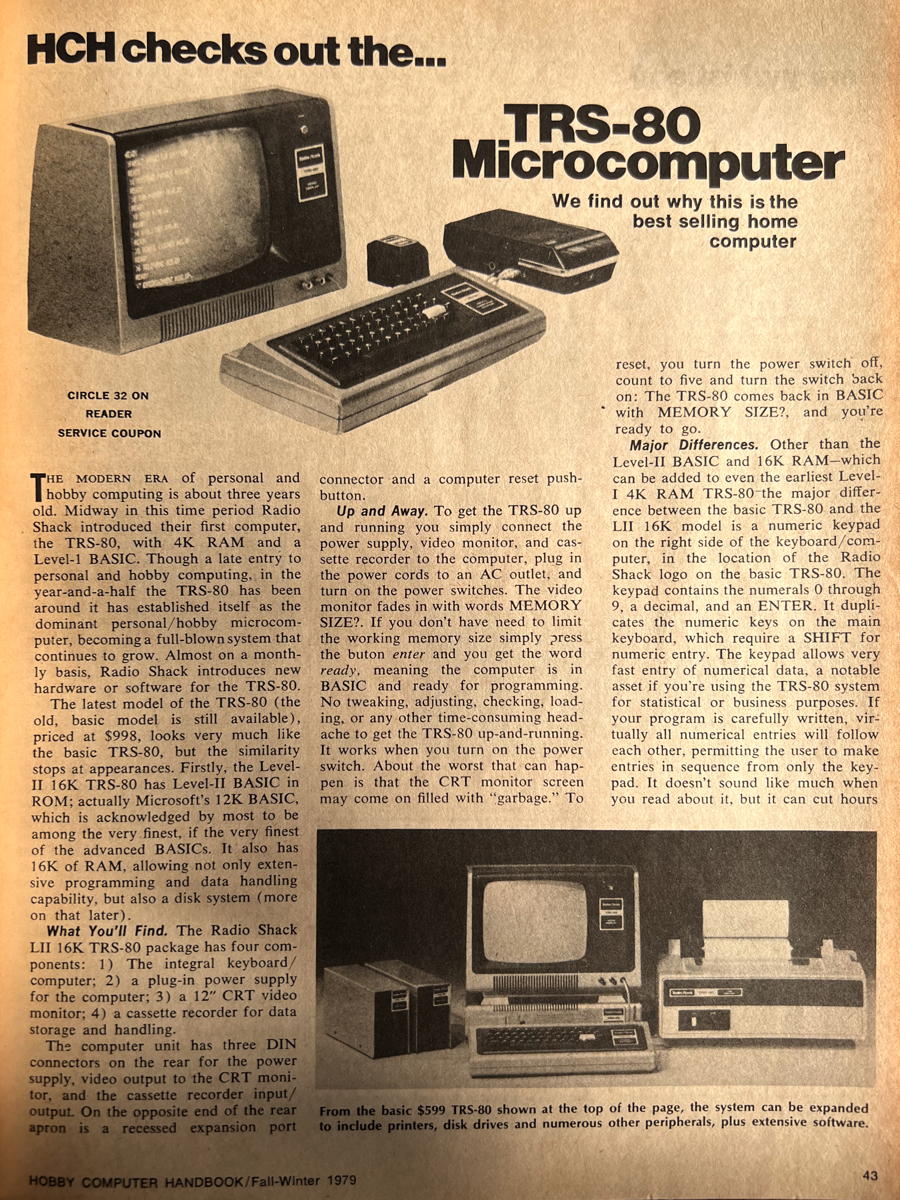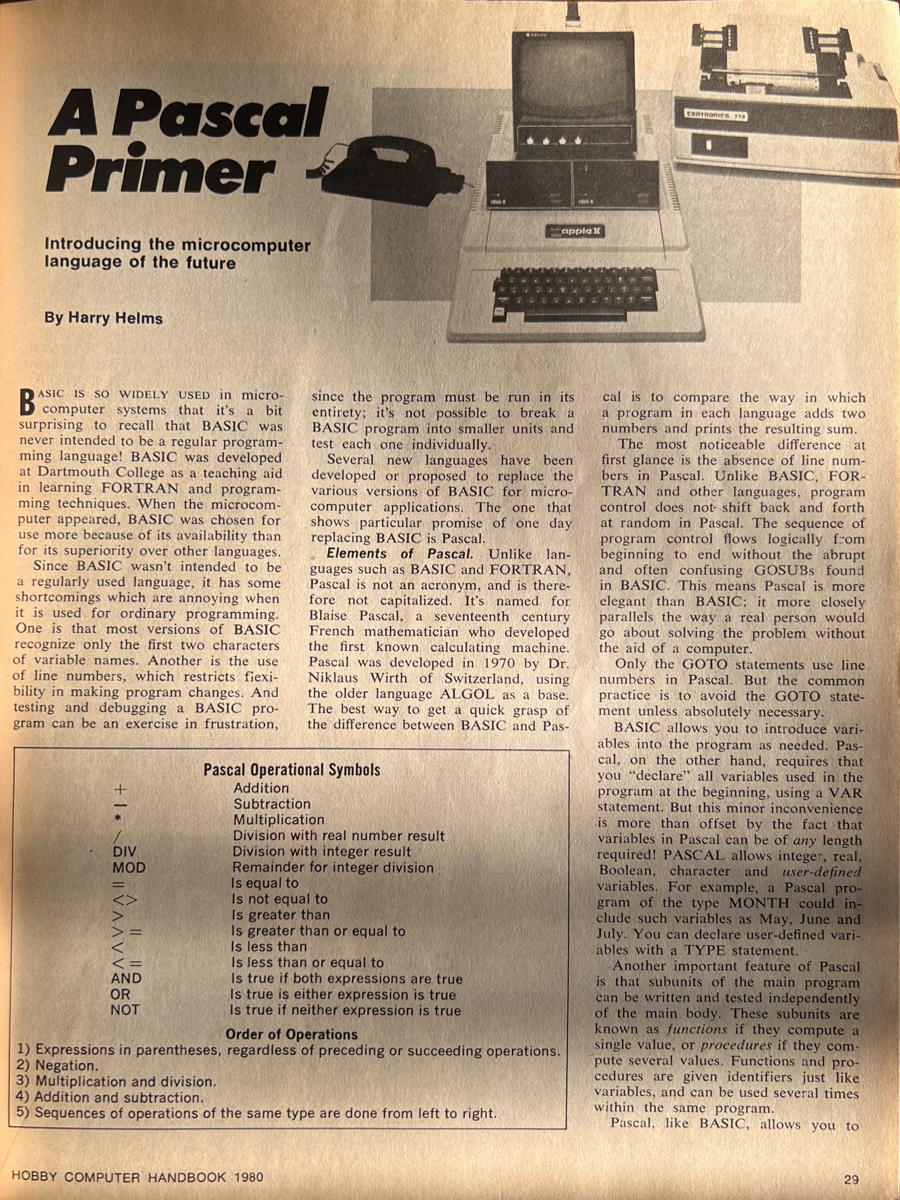Hobby Computer Handbook
In August I bought what I think is the final issue in an obscure early personal computer magazine that is probably of interest only to me. Hobby Computer Handbook was a publication of Elementary Electronics; it came out one or two times a year and may have collected computer-related content from its parent magazine.
The “Fall/Winter 1979 Edition” convinced me that a computer would be a better purchase than a programmable calculator. I found it in the magazine rack of one of our two local grocery stores and read it cover to cover several times. Its articles on BASIC allowed me to write BASIC programs, and so learn BASIC, before I had a computer to write on. None of them worked, of course, but it was a valuable experience. As much as I enjoy seat-of-the-pants scripting, some of my greatest successes come from planning out program logic far from a keyboard.
I also enjoyed the advertisements for computers and computer software. That was possibly the main purpose of the somewhat annual magazine: it was filled with not just advertisements but a “Software Directory”, a comprehensive list of software for various home computers along with thumbnail descriptions of each.
As a teenager who had never considered the possibility of owning a computer, I was amazed at what kinds of software were available. I never meant to write my own word processor. I looked at the prices in Hobby Computer Handbook, saved up what I needed, and brought cash to the annual Hamfest in a nearby city. I figured I’d be able to get a good deal there on software.
I was right, but, Jack-in-the-Beanstalk-style, I saw a Space Invaders game and bought that instead. I figured it would be easy to write a simple word processor, and much more difficult to write an Invaders clone. I was right; I wrote a perfectly passable word processor1, and never did get around to finishing an arcade game.
Hobby Computer Handbook also accounted for my first magazine sale, although not, as far as I can tell, my first publication. I sold a baseball game in BASIC for the TRS-80 Model 1 to them; they paid on acceptance, and I used the money to buy an expansion interface for the TRS-80. But I never saw the game in their magazine. In fact, I never saw another issue after the “1980 Addition”. I didn’t think much of it because our local grocery store was often sporadic in what it chose to get for its very small magazine shelf.2
It’s possible that someone else beat me to other issues, but I looked at that magazine shelf often, as the store was on my paper route. I also never saw another issue at any other store once I went to college a few years later.
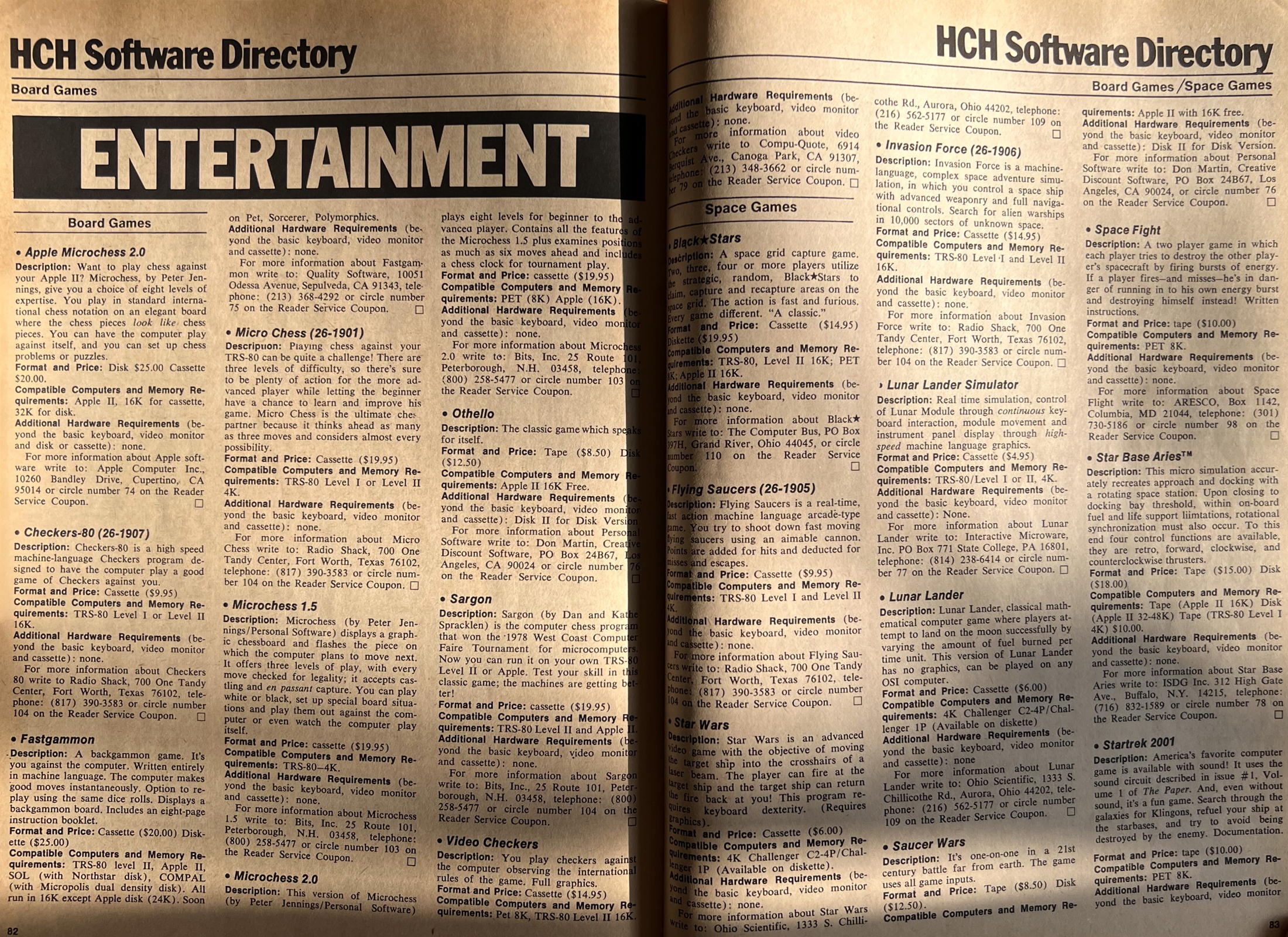
To a kid who had never seen a computer, let alone programmed one, this spread explosively expanded my imagination of what software can do.
It looks like Elementary Electronics planned on making this a yearly publication; what I think is the initial issue was labeled “1979 Edition” across the top. You can download a PDF at the World Radio History’s Elementary Electronics archive. That’s the edition I just found and added to my collection.3 As far as I can tell, there were only four issues: the initial “1979 Edition”, the “Fall/Winter 1979 Edition” and the “1980 Addition [sic]” that I bought back in the day, and the “1981 Edition”, which I picked up on an expensive whim a year ago.
Elementary Electronics themselves shut down in 1981, so it’s likely there were no more issues after the 1981 Edition.
Each issue contained a dense buyers guide; the Fall/Winter 1979 issue summarized the various home computers available at the time and their prices, enough for me to seriously consider saving up for Radio Shack’s TRS-80; it was the only really affordable computer (for a kid on a paper route, anyway) that came complete with its own monitor. I realized that if I watched the classified ads I might be able to find a used one for even less, and I did; it came with a line printer and a 16K memory upgrade; possibly other things I can’t recall. It did not come with the lowercase upgrade. I remember having to deal with the lack of lowercase when I wrote my high school word processor. I’m not absolutely sure I ever did have lowercase on that particular computer. I think I did, but I don’t remember installing the upgrade.
From their 1980 Edition’s “Introduction to Hobby Computers, A Buyer’s Perspective”, I learned:
Memory Capacity. 4K (4000) bytes (words) of free memory will handle a small program such as you’ll find here in HCH and other hobby publications. 8K of memory is even better, as it allows a modest amount of data handling such as required for mailing lists, inventories, etc.; 16K is about ideal for the hobbyist; it will serve most of your needs.
It may sound funny now, but this was basically correct. I had 16k in that first computer, and when I got 48k after selling my game the extra memory was very roomy.
The 1980 issue was also where I first heard about the always-about-to-replace-BASIC Pascal language. It fascinated me partly because in the magazine’s samples of the same program in BASIC and in Pascal, the BASIC version appeared to be far easier to read and follow. This was despite the use of indentation in the Pascal version. And BASIC is far from readable.
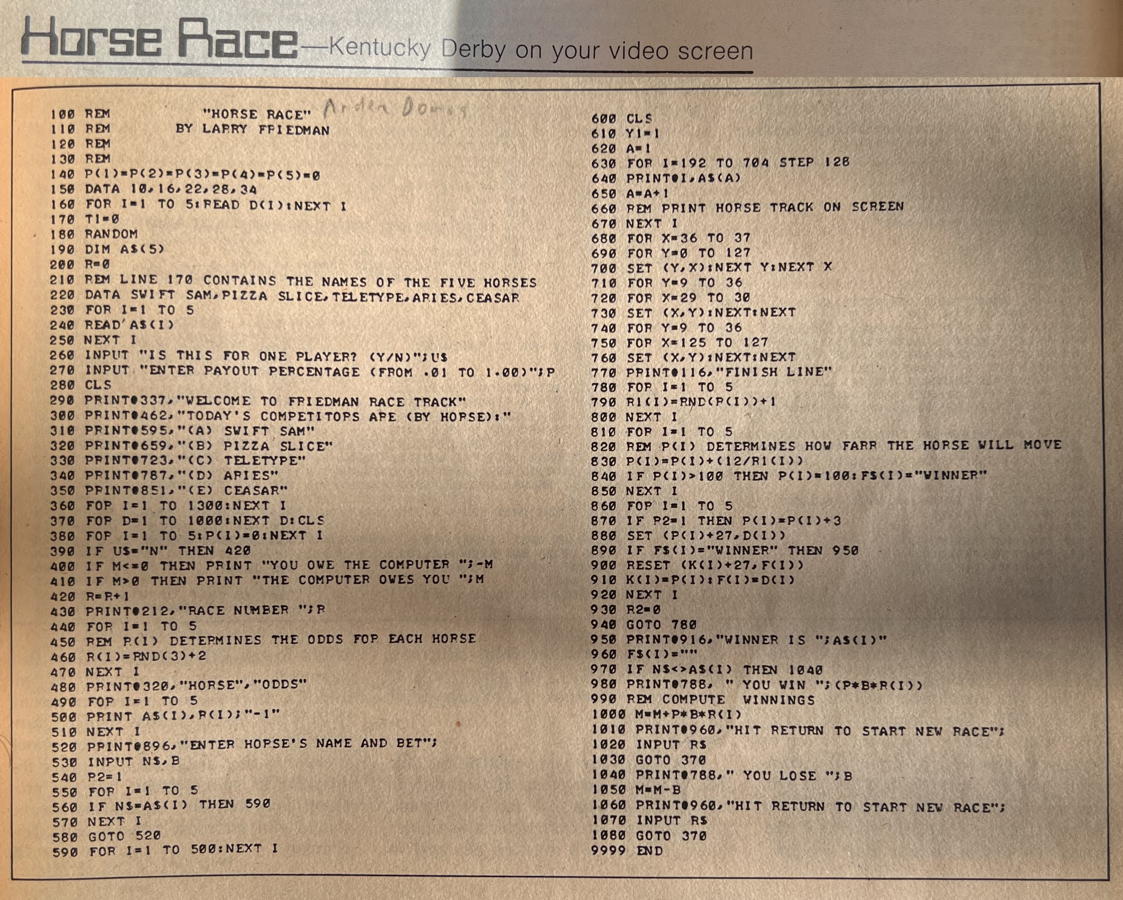
Nothing more exciting than watching individual pixels race across the screen! Judging from the SET(X,Y) this was written specifically for the TRS-80.
That 1980 issue also taught me hexadecimal and provided me with my first “Horse Race” program, by Larry Friedman. He named it Friedman Race Track; I renamed it Arden Downs in honor of Buck Rogers, and of course renamed the horses, too, though I don’t remember any except Taco Salad. Friedman’s names were Swift Sam, Pizza Slice, Teletype, Aries, and Ceasar, an unfortunate typo for a racehorse.
There’s an article about the TRS-80 Expansion Interface, which is probably where I learned about it.
I filled out one of those “more information” cards and, judging from my notes (I was not yet averse to writing in magazines, and didn’t yet realize they would become collectible), asked for information about Radio Shack’s Micro Chess, Invasion Force, Quick Watson!, Double Precision Subroutine, and Level II Basic Instruction Courses; Interactive Microware Inc.’s Lunar Lander Simulator; Acorn Software’s Music; SCEIBI Publications’s Calculating with BASIC booklet; and Software Exchange’s Z80 Telephone Dialer Program.
The issues I’ve bought in the last year are bookends to the ones I read back in the day: the initial “1979 Edition”, and the final “1981 Edition”. That makes for a unique perspective on the changes in home computers over those mere two years. I’ll delve a little more into than in the next post.
- December 8, 2021: Hobby Computer Handbook: From 1979 to 1981
-
To summarize the previous post, Hobby Computer Handbook was a yearly publication of Elementary Electronics. It lasted from 1979 to 1981, when Elementary Electronics ended publication. I recently found the first and final issues, and it’s a fascinating look at the changes in home computers over a very short time period.
1979
For less than the cost of a decent hi-fi system, or a console color TV with remote control, you can have a computer in your own home as powerful as some of the big IBM jobbies, and the whole computer won’t take up much more space than a couple of shoeboxes. If you don’t have room for two shoeboxes worth of electronic hardware you can rent computer time from regional and national companies… Call Data will charge you as low as $6 per hour (educational rate) for using their computer. If all you need is a couple of hours on their computer per month the bill could be less than your phone company charges you for the privilege of having a telephone.—Herb and Lawrence Friedman, Hobby Computer Handbook 1979 Edition, p. 25
One of the amazing things about how quickly the world of home computers was changing are the articles in the 1979 edition. Hobby Computer Handbook highlighted the SWTP 6800, the Heath H8, the Radio Shack TRS-80, the DATAC 1000T, and the Apple II—along with the Texas Instruments 58 Programmable Calculator.
The SWTP was a kit, for about $1,000 if you wanted a video terminal. Some people apparently didn’t: the Heathkit, also a kit, was $375, plus another $110 for a teletype, preferred over video “because it provides a ‘hard copy.’… Actually, the very minimum, consisting of the computer, 8K of memory, a serial I/O-cassette interface, and a used KSR teletype terminal, will cost around $950.”
Compared to the alternative, which was using a typewriter.
↑I had the same problem with comic books. Much of my collection from the era is missing issues in the middle of what were then very exciting storylines!
↑I have a habit of buying books in reverse order. This may be a consequence of haunting used bookstores: newer books in a series are usually more easily found than older ones.
↑
- Elementary Electronics Magazine: David Gleason at World Radio History
- “Elementary Electronics Hobbyist and Experimenter magazine published from 1960 to 1981.”
- HCH checks out the SWTP 6800 Computer (JPEG Image, 313.8 KB)
- “When the computer bug bytes, this new unit is the right Rx.” from the Fall/Winter 1979 edition of Hobby Computer Handbook.
- Hobby Computer Handbook 1979 Edition at Elementary Electronics Magazine (PDF)
- The first issue of Elementary Electronics’s annual computer magazine.
- Hobby Computer Handbook: From 1979 to 1981
- Hobby Computer Handbook lived for four issues, from 1979 to 1981. Back in 1979 and 1980, I bought the middle two issues. I’ve recently had the opportunity to buy and read the bookend issues.
- The way to be a programmer is to program
- How do you become a computer programmer?
- HCH checks out the TRS-80 Microcomputer (JPEG Image, 305.1 KB)
- “We find out why this is the best selling home computer”, from the Fall/Winter 1979 edition of Hobby Computer Handbook.
More computer history
- Creative Computing and BASIC Computer Games in public domain
- David Ahl, editor of Creative Computing and of various BASIC Computer Games books, has released these works into the public domain.
- Hobby Computer Handbook: From 1979 to 1981
- Hobby Computer Handbook lived for four issues, from 1979 to 1981. Back in 1979 and 1980, I bought the middle two issues. I’ve recently had the opportunity to buy and read the bookend issues.
- 8 (bit) Days of Christmas: Day 11 (O Christmas Tree)
- Day 11 of the 8 (bit) days of Christmas is the graphic accompaniment to “O Tannenbaum” from Robert T. Rogers “Holly Jolly Holidays”, from December 1984.
- 8 (bit) Days of Christmas: Day 100 (Hearth)
- Lower resolution graphics were more appropriate for animation, because you could page through up to eight screens like a flip book. This is Eugene Vasconi’s Holiday Hearth from December 1986.
- 8 (bit) Days of Christmas: Day 101 (Rudolph)
- An early form of musical ebook, without scenes illustrating the progress of the song—in this case, Rudolph the Red-Nosed Reindeer. Along with the secret world of POKE.
- Six more pages with the topic computer history, and other related pages
More Hobby Computer Handbook
- Hobby Computer Handbook: From 1979 to 1981
- Hobby Computer Handbook lived for four issues, from 1979 to 1981. Back in 1979 and 1980, I bought the middle two issues. I’ve recently had the opportunity to buy and read the bookend issues.
More magazines
- Hobby Computer Handbook: From 1979 to 1981
- Hobby Computer Handbook lived for four issues, from 1979 to 1981. Back in 1979 and 1980, I bought the middle two issues. I’ve recently had the opportunity to buy and read the bookend issues.

